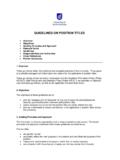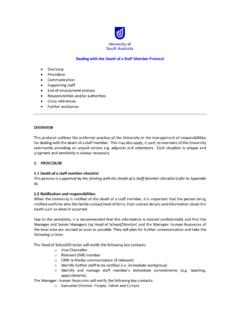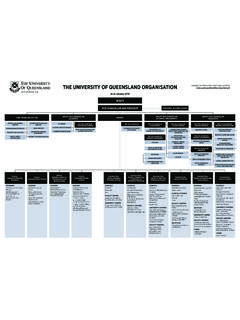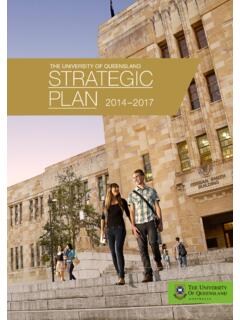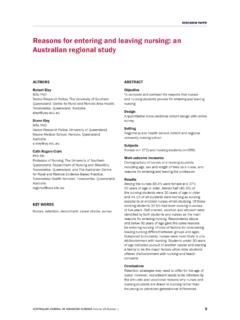Transcription of Annual Workforce and Age Profile Report 2005-2006
1 Annual Workforceand Age ProfileReport 2005-2006As at 31 March 2006 Human Resources UnitJuly 2006 INTRODUCTION The human resource indicators in this Report provide broad Workforce data and analysis, including key Workforce information at the corporate level. This Report will assist managers in the comparison of local information with corporate and benchmarking data to: achieve a greater understanding of the University of South Australia s (UniSA s) Workforce , identify trends and gaps in the Workforce , and provide a measure of human resource strategy success. HUMAN RESOURCE INDICATORS The Workforce planning framework includes the identification of suitable human resource indicators to provide a corporate overview of the Workforce and the continuous monitoring of corporate strategies. The indicators are only intended to provide a snapshot of Workforce issues and are to be considered along with other relevant data.
2 The human resource indicators provide a measure of the human resource capacity of the organisation and the effectiveness of Workforce planning initiatives. This Report includes the following human resource indicators: Workforce size Employment type non casual Temporary staff Staff turnover Length of service Diversity profiling - Indigenous, youth, women in the UniSA Workforce , country of birth, first language and disability Academic and general staff qualifications Career development academic promotion, reclassification of general staff, higher duties opportunities, professional development program and staff study support Leave, including family friendly leave initiatives Occupational Health Safety and Welfare Age Profile BENCHMARKING Where possible, benchmarking information for most indicators has been included and information has been obtained from the following sources.
3 Department of Education, Science & Training (DEST) data 2005 Australian Bureau of Statistics (AusStats 2001 & 2006) Australian Bureau of Statistics, Year Book Australia 2005. Australian Universities HR Benchmarking Program 2006 HR Performance Indicators for the period 2003 2005 (Queensland University of Technology [QUT]) Government of South Australia, Office of Public Employment Workforce Analysis 2005 University of South Australia Annual Workforce Report 2003-2004 & 2004-2005 Mercer HR Consulting, Human Resource Effectiveness Monitor 2005 Advancing the AVCC Action Plan for Women, Cross Institution comparisons based on 2005 data, prepared by QUT for the Australian Technology Network (ATN) TREND The Annual Workforce Profile Report provides trends against measures for the last three years. The trend analysis for each indicator can be used to plan, implement and evaluate human resource policies and initiatives.
4 This year the Report includes a separate section on the age Profile of the University. Annual Workforce Report The Annual Workforce Profile Report forms part of the University s Workforce planning and reporting framework and provides an overview of the Workforce Profile , establishes base measures where appropriate and presents an analysis of the data. The data in this Report is based on the Annual data provided to DEST, which is finalised in June. It is for this reason that the data is either static as at 31 March 2006 or reflects data captured from 1 April 2005 to 31 March 2006. The exception to this is casual employment where data is provided based on calendar year (1 January to 31 December 2005). At the beginning of 2006, the Portfolio: Access and Learning Support changed its name to Portfolio: Academic. At this time the Whyalla Campus came under the responsibility of the Portfolio: Organisational Strategy and Change.
5 Tables with historical data have changed to reflect the new name. For further advice and information please contact the Director: Human Resources, Shard Lorenzo or the Remuneration and Workforce Strategy Team in the Human Resources Unit (HRU): Carroll DeVizio Senior Consultant: Remuneration and Workforce Strategy Phone: x21641 Bernice McGrath Consultant: Remuneration and Workforce Strategy Phone: x21613 TABLE OF CONTENTS Results Overview: 2003 2004, 2004 2005 and 2005 2006 1 Executive Summary 3 Overview 5 PART A: Workforce PROFILING 7 1. Workforce Size 7 2. Employment Type Non-Casual 11 Continuing and Fixed-Term Staff 11 Employment Type by Division and Portfolio 13 3. Temporary Staff 17 Casual Staff 17 4.
6 Staff Turnover 25 5. Length of Service 29 6. Diversity 31 Indigenous Employment 32 Youth Employment 35 Women in the UniSA Workforce 37 Country of Birth 43 First Languages 45 Disability 47 7. Staff Qualifications 49 Academic Staff Qualifications 49 General Staff Qualifications 52 8. Career Development 55 Academic Promotions 55 General Staff Reclassifications 58 Higher Duties Opportunities for General Staff 60 Professional Experience Program 62 Staff Study Support 63 9.
7 Leave 65 Planned and Unplanned Leave 65 Recreation Leave Liability 68 Long Service Leave Liability 70 Family Friendly Leave Initiatives 72 PART B: OCCUPATIONAL HEALTH & SAFETY 75 1. Workers Compensation 75 Total Number of Workers Compensation Claims & Types of Injury or Illness 75 Total Number of Days Lost 77 Total Cost of Claims 78 Incidence Rate 79 Frequency Rate 80 Average Time Lost Rate 81 PART C: ANALYSIS OF THE AGE Profile OF UNISA 83 1. Age 83 Background 83 UniSA s Age Profile 85 Age and Gender 87 Classification 91 Division and Portfolio 93 2.
8 Recruitment 95 Background 95 Ageing and Recruitment at UniSA 95 3. Exits 101 Background 101 Ageing and Retention at UniSA 101 4. Health and Wellbeing 107 Background 107 Ageing and Unplanned Leave at UniSA 107 Ageing and Injury at UniSA 108 5. Summary 109 TABLE LISTING Table 1 Continuing and Fixed-Term and Casual Staff FTE by Academic and General and Division and Portfolio as at 31 March 2004, 2005 and 2006 Table 2 Total FTE numbers and percentage change by Division and Portfolio as at 31 March 2004, 2005 and 2006 (including casuals) Table 3 Academic and General by Division and Portfolio as at 31 March 2006 Table 4 Employment Type by Division and Portfolio as at 31 March 2006 (excluding casuals)
9 Table 5 Casual Hours and FTE by Division and Portfolio, 1 January 2005 to 31 December 2005 Table 6 Total University Summary of Casual Hours and FTE by Award and Work Type, 1 January 2005 to 31 December 2005 Table 7 Academic Casual Hours and FTE by Division and Portfolio and Work Type, 1 January 2005 to 31 December 2005 Table 8 General Casual Work Code Other Hours and FTE by Division and Portfolio, 1 January 2005 to 31 December 2005 Table 9 Casual Hours and FTE by Division and Portfolio and Gender,1 January 2005 to 31 December 2005 Table 10 University-wide Voluntary and Involuntary Staff Turnover Annualised, 1 April 2005 to 31 March 2006 Table 11 Number of Involuntary and Voluntary Staff Separations by Gender and Academic and General, 1 April 2005 to 31 March 2006 Table 12 Indigenous Employment as a Percentage of Staff as at 31 March 2006 Table 13 Youth Employment as a Percentage of General Staff FTE as at 31 March 2006 Table 14 General Staff Youth Employment (FTE) by Division and Portfolio as at 31 March 2006 Table 15 Female Staff Percentages by Academic and General and Division and Portfolio as at 31 March 2006 Table 16 Staff Gender (headcount)
10 Across all Levels as at 31 March 2006 Table 17 Staff as a Percentage by Country of Birth as at 31 March 2006 Table 18 First Language as a Percentage of Staff as at 31 March 2006 Table 19 Number of Staff who identified as having a Disability as at 31 March 2006 Table 20 Academic Staff Highest Qualification Completed as a Percentage of Academic Staff by Division and Portfolio as at 31 March 2006 Table 21 Academic Staff Highest Qualification Completed as a Percentage of Academic Staff by Academic Level as at 31 March 2006 Table 22 General Staff Highest Qualification Completed as a Percentage of General Staff by Division and Portfolio as at 31 March 2006 Table 23 Number of Applications Received for Academic Promotion for 2005 round Table 24 Number of Successful Applications for Academic Promotion for 2005 round Table 25 Academic Application for Promotion Rate and Academic Promotion Rate for Academic Promotion for 2005 Round TABLE LISTING (cont.)
